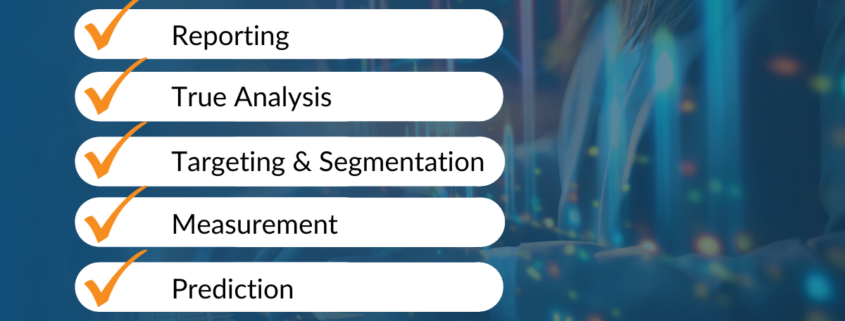5 Essential Jobs in a Go-to-Market Analytics Team
In the fast-paced B2B marketing and sales industry, analytics have become indispensable. Successful go-to-market strategies require a thorough understanding of the five essential jobs that analytics teams perform to unlock success. This blog delves into each job, providing insights and best practices for optimal results.
What are the Five Essential Jobs?
1) The What: Reporting
Definition: The What job is about reporting the facts. How many leads are we generating, how quickly are revenue analytics leads moving through the funnel, how much are we spending on marketing, and how is each rep doing versus their goals? This is the most basic, and also the most important, “table stakes” job. Fortunately, it can be mostly automated via business intelligence tools.
Reporting is the lifeblood of sales and marketing executives, ideally offering near-real-time performance insights. Different types of reports provide insights into various parts of the pipeline.
Types of Reports:
- Activity-Based Reports provide insights into day-to-day actions and engagements that drive a B2B marketing and sales process.
- Performance-Based Reports look beyond activities and assess the results and outcomes of sales and marketing efforts.
- Forecasting Reports anticipate future sales movements and market trends.
- Customer Reports offer insights into customers’ acquisition cost (CAC), their value over time, and the results of targeted marketing efforts.
Reporting Best Practices:
- Ensure data quality for trusted reports.
- Start with a simple report and gradually expand.
- Establish a common data language (taxonomy).
- Address duplicate data issues for accurate reporting.
- Employ centralized data storage for effective reporting.
2) The Why: True Analysis
Definition: The Why job is most akin to the Greek root words of analytics—literally “untying a knot.” Analysts answer never-ending ad hoc questions from executives on almost any topic imaginable. This process cannot be automated; analysts need fast access to clean data and sound data science tools to get results.
Marketing and sales analysts are crucial to the success of a commercial team; they perform the vital task of true analysis, combining business and data science skills to unravel insights and drive informed decision-making.
Key Requirements for Analysts:
- Fast compute and affordable, limitless storage.
- Reproducible analysis through text-based data science languages.
- Timely access to relevant data for analysis.
Agile Project Management for Analysis:
- Use a Kanban approach for task listing and prioritization.
- Maintain a clear list of analysis tasks, stakeholders, and due dates.
3) The Who: Targeting and Segmentation
Definition: The Who job deals with accounts and customers—segmenting them, targeting them, and serving them the right content. This job provides the strategic input for Account-Based Marketing (ABM).
Effective B2B targeting involves understanding market dynamics, including segment targeting, within-segment targeting, and within-account segmentation. The analytics team must integrate various data sources to create target lists and buyer archetypes.
Data Integration for Targeting:
- Segment and Within-Segment Targeting: Industry trends, firmographic data, behavioral data.
- Account Targeting: Master hierarchical table structure for accounts.
- Within Account Targeting: Categorize key players, map decision hierarchies, and use qualitative and quantitative research.
Actionability Requirements for Segmentation:
- Define actionability requirements before segmentation.
- Assign segments back to leads and contacts with reasonable accuracy.
4) The How: Measurement
Definition: The How job is about measuring marketing and sales: How did we get this lead? And what can we do to get more like it? In B2C companies, media mix modeling (MMM) is commonly used to get these answers. This is trickier for B2B companies but just as critical.
B2B marketing measurement poses unique challenges, requiring a nuanced approach. Small-n deals, multiple objectives, chunkier tactics, long-time scales, audience complexity, and sales integration demand a hybrid measurement approach.
Measurement Challenges and Approaches:
- Separate measurement for different objectives (awareness, demand generation, sales enablement).
- Hybrid approaches combining econometric, deterministic, test-based, and heuristic-based methods.
- Leverage management insights to complement data-driven models.
5) What’s Upcoming: Prediction
Definition: The What’s Upcoming job predicts what customers will do or respond to. It is the “action” side of account-based marketing and depends on machine learning techniques (predicting and classifying based on signals).
Machine learning plays a pivotal role in predicting outcomes in B2B go-to-market analytics. However, B2B predictive modeling faces challenges such as sparser signals, fewer observations, and a need for a deeper understanding of individual features.
Challenges and Considerations:
- Signals are sparser in B2B predictive modeling.
- Fewer observations require a more challenging modeling approach.
- Consider outsourcing to ABM platforms but retain a team of predictive data scientists for deeper insights.
Unlocking Success in B2B Go-to-Market Analytics
Mastering the five essential jobs in B2B go-to-market analytics—reporting, true analysis, targeting and segmentation, measurement, and prediction—is key to unlocking success. Staying ahead with innovative approaches and a robust analytics strategy will pave the way for sustained growth as the landscape evolves.
A Roadmap for Modern B2B Go-to-Market – Part 2: Operations and Analytics
Access this whitepaper to learn more about the processes, technology, and analytics needed to meet revenue goals.





